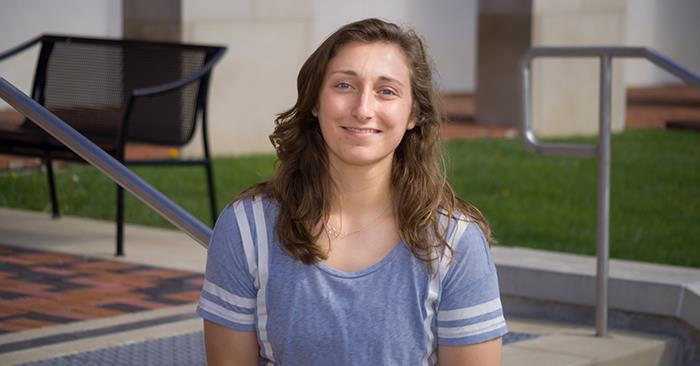Rechav Awarded NSF Research Fellowship

Senior physics major Zoe Rechav has received a competitive Graduate Research Fellowship from the National Science Foundation (NSF).
Since 1952, NSF has funded more than 60,000 Graduate Research Fellowships out of more than half a million applicants. The program recognizes and supports outstanding graduate students in NSF-supported science, technology, engineering and mathematics disciplines who are pursuing research-based master’s and doctoral degrees at accredited United States institutions.
During her time at Truman, Rechav has done research under Timothy Wiser, assistant professor of physics, which includes identifying particle tracks in cloud chambers using video analysis techniques.
Rechav has also participated in two projects at Brookhaven National Laboratory in New York. In one, she studied the decay of an unstable heavy nuclei, europium, into another, gadolinium, to better understand quantum phase transitions. The goal was to connect the pieces together to understand how the quantum phase transition from europium to gadolinium happens. Rechav also worked on a project pertaining to radiation safety in particle physics at the Relativistic Heavy Ion Collider (RHIC), where scientists perform experiments that require high-velocity particle collisions. She investigated the highest dose of radiation an individual could receive during a particle collision to determine if the entrance to the RHIC was safe to enter.
After graduation, Rechav will pursue a Ph.D. in physics at the University of Wisconsin-Madison. She will conduct research at the Wisconsin IceCube Particle Astrophysics Center (WIPAC), focusing on the study of cosmic rays and ultra-high energy neutrinos. Cosmic rays are showers of particles that are generated from sources outside of the Milky Way galaxy. These cosmic rays generate cosmic neutrinos, which are neutral particles that do not interact well with other particles.
“Since neutrinos don’t interact well with other particles, they are perfect messengers to learn and understand information about where they came from and how they traveled here,” Rechav said. “By using methods to detect and analyze the characteristics of ultra-high energy neutrinos, we can make discoveries that impact our understanding of the fundamental nature of particles.”
The fellowship provides three years of support, including a $34,000 stipend along with a $12,000 cost-of-education allowance for tuition and fees (paid to the institution), as well as access to opportunities for professional development available to NSF-supported graduate students.
As the oldest graduate fellowship of its kind, the Graduate Research Fellowship Program has a long history of selecting recipients who achieve high levels of success in their future academic and professional careers. The reputation of the program follows recipients and often helps them become life-long leaders that contribute significantly to both scientific innovation and teaching. Currently, 42 Fellows have gone on to become Nobel laureates, and more than 450 have become members of the National Academy of Sciences.
